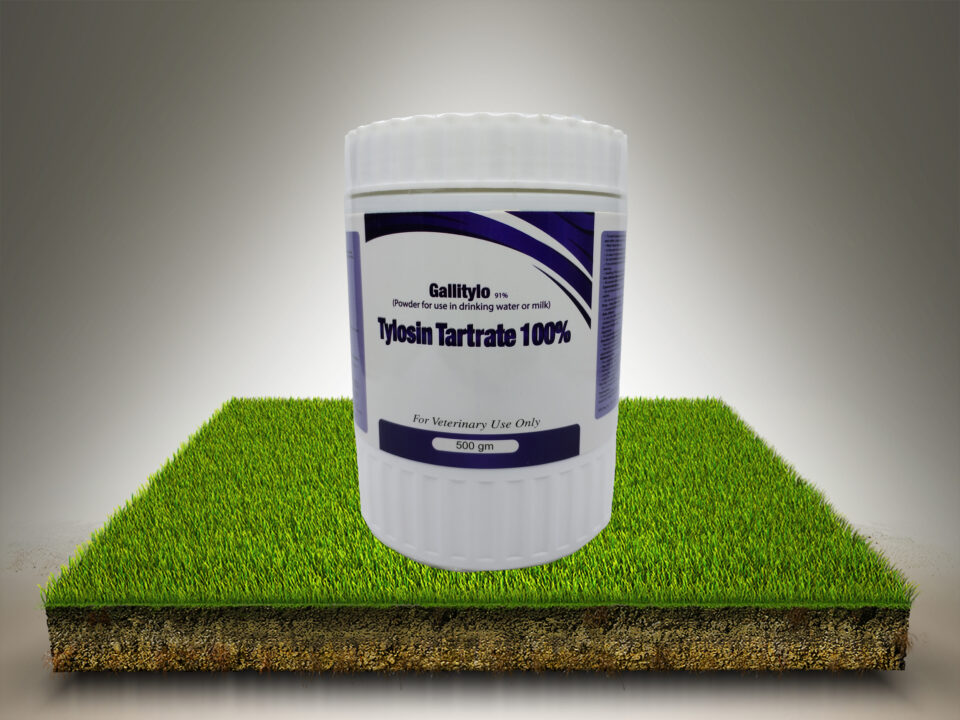
Sulfatopazine

Tetramarti
( W.S.P )
For Veterinary Use Only
Composition :
Each 1 gm contains:
Trimethoprim 125 mg
Sulfadiazine Sodium 625 mg
Properties:
Alone, sulfonamides are bacteriostatic agents and trimethoprim is bacteriostatic, but in combination, the potentiated sulfas are bactericidal. Potentiated sulfas sequentially inhibit enzymes in the folic acid pathway, thereby inhibiting bacterial thymidine synthesis. The sulphonamide blocks the conversion of para-aminobenzoic acid (PABA) to dihydrofolic acid (DFA), and trimethoprim blocks the conversion of DFA to tetrahydrofolic acid by inhibiting dihydrofolate reductase.
The in vitro optimal ratio for most susceptible bacteria is approximately 1:20 (trimethoprim : sulfa), but synergistic activity can reportedly occur with ratios of 1:1 – 1:40. The serum concentration of the trimethoprim component is considered to be more important than the sulfa concentration. For most susceptible bacteria, the MIC’s for TMP are generally above 0.5 micrograms/ml. The potentiated sulfas have a fairly broad spectrum of activity. Gram positive bacteria that are generally susceptible include most streptococci, many strains of staphylococcus and Nocardia. Many gram negative organisms of the family Enterobacteriaceae are susceptible to the potentiated sulfas, but not Pseudomonas aeruginosa. Some protozoa (Pneumocystis carinii, Coccidia and Toxoplasma) are also inhibited by the combination. Potentiated sulfas reportedly have little activity against most anaerobes, but opinions on this vary. Resistance will develop slower to the combination of drugs than to either one alone. In gram negative organisms, resistance is usually plasmid-mediated.
Indications:
Swine : For the treatment of the respiratory disease complex Caused by Mycoplasma hyopneumoniae, Bordetella bronchiseptica, and Actinobacillus, pleuropneumoniae. Pasteurella multocida, Haemophilus parasuis, Streptococcus suis, Actinobacillus suis, Arcanobacterium pyogenes. And Salmonella choleraesuis
Broiler Chickens : For the treatment of enteric and respiratory bacterial infections Caused by Escherichia coli
Target Species:
Broiler chickens and swine
Dose for whole product:
Broiler Chickens : 40 mg per 1 kg bodyweight birds daily for 7 days..
Swine : 40 mg per 1 kg pig weight daily for 5 days.
Warnings and precautions:
- Do not handle this product if you know you are sensitive to sulphonamides.
If you develop symptoms following exposure such as a skin rash, you should seek medical advice and show the doctor this warning. - Eggs from treated broiler chickens must not be used for human consumption
- Birds must not be slaughtered for human Consumption during treatment
Contra-indications
trimethoprim/ sulfadiazine should not be used in dogs or horses showing marked liver parenchymal damage, blood dyscrasias, or in those with a history of sulfonamide sensitivity. It is not for use in horses (or approved for other animals) intended for food. This combination should be used with caution in patients with pre-existing hepatic disease. Safety of trimethoprim/sulfa has not been clearly established in pregnant animals. Reports of teratogenicity (cleft palate) have been reported in some rat studies. Fetal mortality was also increased in rabbits receiving high doses of trimethoprim. Dog studies have not demonstrated any teratogenic effects. However, this combination should be used in pregnant females only when the benefits clearly outweigh the risks of use. Studies thus far in male animals have not demonstrated any decreases in reproductive performance.
Adverse effects:
Hypersensitivity reactions and hematologic effects (anemias, thrombocytopenia, or leukopenias) may also be seen; long term therapy should include periodic hematologic monitoring.
Withdrawal periods:
Swine: 14 days before slaughter.
Broiler Chickens: 10 days before slaughter.
Storage condition:
Store at temperature not exceeding 30 C in dry place and used immediately after opening and used within 24 hours after reconstitution when stored at temperature not exceeding 30 C
Packaging:
Transparent (LDPE) Plastic Bag containing 20,25,50,100,150, 250,500 gm, 1 ,5,10,15 , 20,25 kg water soluble powder in ( HDPE ) plastic jar with an outer label with (HDPE) Plastic Cap




